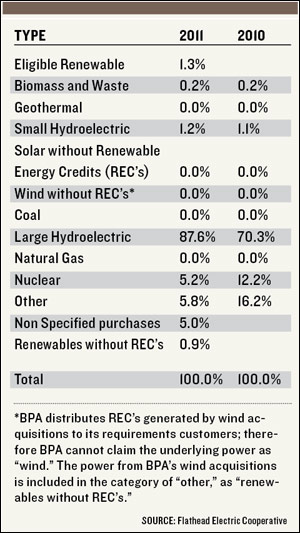One common question we get asked at the Co-op is how much of my energy comes from the dams and how much comes from other sources? This is a good question and has a relatively simple answer on its face, but it also invokes some questions about the true nature of the electric grid. Contractually, 97 percent of the energy consumed in our Northwest Montana service territory is purchased by Flathead Electric Co-op from Bonneville Power Administration (BPA).
The remainder is served by renewable biomass and biogas resources, such as our Flathead County Landfill gas-to-energy facility.
Each year, BPA releases a report on where its generation comes from by fuel source. In the last reporting period, BPA’s generation mix was:
 |
Of BPA’s fuel mix, 87.6 percent is zero-emission generation from the Federal Columbia River Power System. Another 5.2 percent is from Columbia Generating Station in Washington and the “other” includes a mix of generation and market purchases which could come from almost any source – including coal generation – but likely includes significant wind generation that developers sell into the market.
So, if we apply these to the energy that contractually flows to your house, then 85 percent of the energy is still zero emission (blue) energy from the region’s dams. Since the rest of the generation sources can either be tied to Eligible Renewables owned or controlled by BPA or Flathead or Non-Eligible Renewables that (regardless of the legislative status) are very low emission, the only portion of the energy deliveries to your house here in Northwest Montana, that potentially have high emissions, is the roughly 6 percent of energy that is Other/Non-Specified.
It is my opinion that since the Pacific Northwest has been long on resources, due to the massive investments in wind energy and the needed investments in natural gas plants to smooth their output, that much of this energy is low emission as well. So, thanks to your Federal Hydro System, Flathead has one of the greenest resource portfolios in the northwest, without the need for extensive mandates and investments in solar panels and wind turbines occurring elsewhere.
So, this is all the contractual flow of power between entities, but electrons do not know who bought and sold them. Consequently, the actual energy that comes out of your outlet could have come from Hungry Horse Dam, Libby Dam, Kerr Dam, or some resource in eastern Montana or Washington that was needed to put energy on the grid. It’s all about balancing the power that is needed with the power that is available.